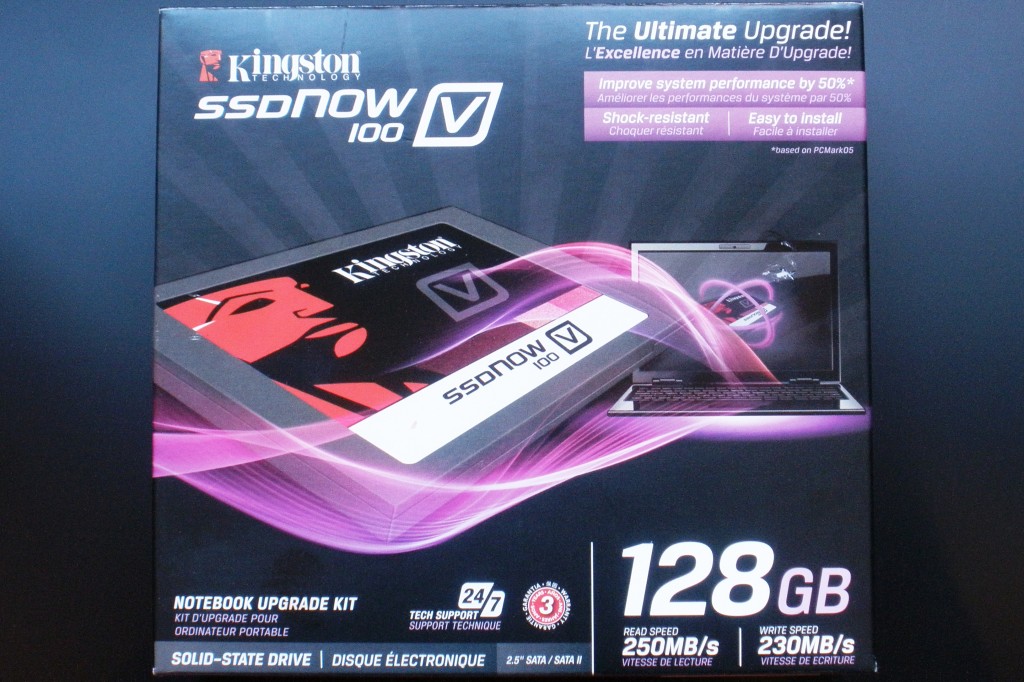There has to be something said for simplicity. Kingston’s new release of the Kingston SSDNow V100 Series line of SSD is going to hit the heart of the typical computer enthusiast who wants to be able to make the transition to SSDs quickly and easily. In refreshing this SSD line, Kingston thought of the consumer first matching that simplicity with performance and value. We think it only fair, after a brief overview, to start things off by evaluating how simple it is to get this SSD up and running..
OVERVIEW
The Kingston V100 series of solid state drives is available in 3 capacities ranging from 64GB to 256GB and are recommended pricing is $119.99, 224.99 and 489.99. The drive has a 3 year warranty, 24/7 technical support and can be purchased with an upgrade kit containing an external adapter, cord and bootable DVD. The DVD has Kingston’s proprietary copy of Acronis True Image for the hard drive to SSD transition. Its performance boasts of 250MB/s read and 230MB/s write for the higher capacity drives but the 64GB version has a lower write performance of 145MB/s which is still an excellent transfer rate.
.
.
.
.
SIMPLICITY
When we open the package, we find the SSD, an external adapter, a chord and a DVD. We simply slid the drive into the external adapter, connected it to the laptop by USB and rebooted the system to DVD and followed the instructions laid out by Acronis. From there, we swapped hard drive for SSD and that was it!!!

In speaking with Kingston, they chuckled and stated that was actually the hard way because they recommend switching the hard drive and SSD first, then placing the hard drive in the external adapter, plugging it into the system and booting from the DVD. At the end, the system is ready to go and we have a bonus we never expected. The hard drive is additional storage for yourself as it is still connected to your system within the external adapter. Kingston recommends following of the instructions which are contained on the DVD itself.
PHYSICAL CHARACTERISTICS
 The SSD components are encased in a gun metal colored smooth metal exterior with the famous Kingston logo on the front. As we are seeing more often, there is a security sticker which will immediately void ones warranty should they elect to see what is inside the unit. We prefer to get a good look inside and take some good shots to explain the SSD componentry and save you the urge to get at that yourself.
The SSD components are encased in a gun metal colored smooth metal exterior with the famous Kingston logo on the front. As we are seeing more often, there is a security sticker which will immediately void ones warranty should they elect to see what is inside the unit. We prefer to get a good look inside and take some good shots to explain the SSD componentry and save you the urge to get at that yourself.
.
.
.
.
.
.
.
.
.
As we look from the left, the first chip we see is on an angle and is the Toshiba JMF618 controller which is a rebadged version of the JMF612 and designed in cooperation with JMicron. The refresh of this drive has meant the addition of a 256GB verion to the line through the use of Toshiba 32nm NAND. There are 18x8GB NAND flash memory chips which total a capacity of 128GB and also a 64MB cache which is seen on the chip labelled ‘Mira’ on the back of the board.
- Form factor : 2.5″
- Interface : SATA 1.5 Gb/sec. and 3.0 Gb/sec.
- Capacities* : 64GB, 128GB, 256GB
- Dimensions : 69.85mm x 100mm x 9.5mm
- Weight : 78 grams
- Storage Temperatures : -40°C to 85°C
- Operating Temperatures : 0°C to 70°C
- Vibration Operating : 2.17G
- Vibration Non-Operation : 20G
- Sequential read throughput : 256GB – 250MB/sec. read/128GB – 250MB/sec. read/64GB – 250MB/sec. read
- Sequential write throughput : 256GB – 230MB/sec write/128GB – 230MB/sec write/64GB – 145MB/sec write
- PCMARK Vantage HDD Suite Score+ : 64GB – 19,932/128GB – 20,571/256GB – 19,910
- Power Specs : 6.4 W (TYP) Active / 1.0W (TYP) Idle
- MTBF : 1,000,000 Hrs
 The SSD Review The Worlds Dedicated SSD Education and Review Resource |
The SSD Review The Worlds Dedicated SSD Education and Review Resource | 

Hi, i was curious if this drive has any kind of heat dissipating material between the chips and the aluminium case (thermal pads or paste). Or do the chips at least, touch the case?
RESPONSE: Solid state drives have no heat issues whatsoever even when RAIDED. There are no moving parts.
Yes, i know that. But, even so, chips (memory and controller) do get hot. Like a CPU or RAM. I suppose that if you’ll get an ssd drive hot enough, you could either burn it, or make it throtle if it has thermal protection built in. My V100 drive gets up to 55 degrees Celsius during zero-fill in HDTune, with room temperature at about 20 degrees. I’m worried that in the summer, with ambient temps going up to 30-35 degrees, it’ll come pretty darn close to the maximum operating temperature (70 degr). Also, what about those drives used in laptops in a hot summer day?
Still waiting for an answer to my question, do they have thermal pads on the chips, like the SSDNow V+ gen2 (SNVP325), or like the SSDNow V (SNV425)?
I’ve asked the same thing in the forum, we could discuss this further there.